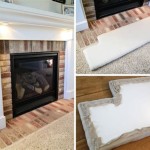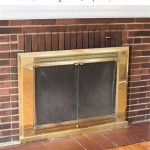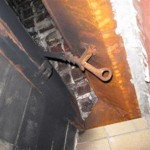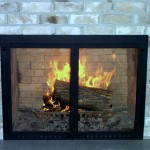Portable Air Conditioner Exhaust Through Fireplace: A Practical Guide
Portable air conditioners offer a flexible and convenient cooling solution, particularly for individuals who lack central air conditioning or wish to supplement existing systems. However, effectively venting the hot air exhaust from these units is crucial for optimal performance and energy efficiency. One potential, and often considered, venting option is through the fireplace. This article examines the feasibility, benefits, drawbacks, and safety considerations associated with venting a portable air conditioner through a fireplace.
The primary function of a portable air conditioner is to remove heat from a room and expel it outside. This is achieved through a process where the unit absorbs heat, cools the air, and then vents the hot air through an exhaust hose. Proper venting is essential because if the hot air is not adequately expelled, it will simply recirculate within the room, negating the cooling effect of the air conditioner and potentially increasing energy consumption. The standard method of venting involves using a window venting kit, which allows the exhaust hose to be directed outside through a partially open window. However, circumstances may arise where a window is unavailable or unsuitable for venting, leading homeowners to explore alternative options, such as using a fireplace.
Understanding Fireplace Ventilation Principles
A fireplace is designed to channel smoke and other combustion byproducts up and out of a building through a chimney. This natural upward draft, known as the "chimney effect," is created by the difference in temperature and pressure between the inside of the chimney and the outside environment. Hot air rises, creating a suction force that pulls air from the room into the fireplace and up the chimney. This principle is what makes a fireplace an appealing potential pathway for venting a portable air conditioner.
However, it's vital to understand that fireplaces are designed for intermittent, high-temperature exhaust from wood or gas combustion. The exhaust from a portable air conditioner, while warm, is significantly different in temperature and composition. Furthermore, fireplaces are not typically airtight. Gaps and leaks within the chimney structure can compromise the ventilation efficiency and potentially lead to backdrafting, where the warm air is drawn back into the room instead of being expelled.
The effectiveness of venting a portable air conditioner through a fireplace largely depends on the condition of the fireplace and chimney, including the presence of a damper, the integrity of the flue lining, and the absence of obstructions. A poorly maintained or damaged fireplace can negate the benefits of using it for ventilation and may even pose safety hazards.
Advantages of Venting Through a Fireplace
Despite the potential drawbacks, venting a portable air conditioner through a fireplace can offer several advantages under specific circumstances. The most prominent benefit is the elimination of the need for a window venting kit. This is particularly useful in situations where windows are inaccessible, unsuitable for venting, or when the homeowner prefers to avoid altering the window arrangement.
Another potential advantage is aesthetic. Some homeowners find window venting kits visually unappealing, as they can obstruct the view and detract from the appearance of the room. Using a fireplace for venting can provide a more discreet and less intrusive solution, especially if the fireplace is not actively in use. The exhaust hose can be hidden within the fireplace opening, minimizing its visibility.
In certain scenarios, a fireplace may offer a more direct and efficient venting path compared to a window. If the fireplace is located closer to the air conditioner than a window, the exhaust hose can be shorter, reducing the potential for heat loss along the hose and improving the overall cooling efficiency of the unit. This advantage is particularly relevant in larger rooms where the air conditioner needs to be positioned further away from a window.
Disadvantages and Safety Considerations
Venting a portable air conditioner through a fireplace also presents several disadvantages and safety concerns that must be carefully considered. One of the primary concerns is the potential for reduced energy efficiency. As mentioned earlier, fireplaces are not typically airtight. Air leaks within the chimney structure can allow warm air to escape back into the room, counteracting the cooling effect of the air conditioner. This can lead to increased energy consumption and higher utility bills.
Another significant drawback is the potential for backdrafting. If the chimney draft is insufficient, the warm air from the air conditioner may be drawn back into the room, rather than being expelled. This can occur due to various factors, such as external wind conditions, the presence of other exhaust systems in the house (e.g., kitchen range hood), or a poorly maintained chimney. Backdrafting not only reduces the cooling effectiveness but can also introduce odors and potential pollutants into the room.
Safety considerations are paramount when considering fireplace venting. It is crucial to ensure that the fireplace is clean and free from creosote buildup. Creosote is a flammable substance that accumulates in chimneys from wood-burning fires. While the exhaust from a portable air conditioner is not inherently flammable, the introduction of warm air into a creosote-laden chimney could potentially increase the risk of a chimney fire. Therefore, a professional chimney sweep should inspect and clean the fireplace before using it for air conditioner venting.
Furthermore, the damper, which is a hinged plate that controls airflow through the chimney, must be properly secured in the open position during air conditioner operation. If the damper is partially or fully closed, it will obstruct the airflow and cause the warm air to back up into the room. It's advisable to physically lock the damper open to prevent accidental closure. If the damper is damaged or missing, it should be repaired or replaced before using the fireplace for venting.
Connecting the exhaust hose to the fireplace opening requires careful attention. The connection should be as airtight as possible to minimize air leakage. This can be achieved using materials such as heat-resistant tape, foam insulation, or custom-made adapters. It's important to ensure that the connection is secure and that the exhaust hose is properly supported to prevent it from falling or becoming dislodged.
Finally, it is imperative to monitor the performance of the air conditioner and the temperature of the exhaust hose. If the air conditioner is not cooling effectively, or if the exhaust hose becomes excessively hot, it may indicate a problem with the venting system. In such cases, the air conditioner should be turned off, and the venting system should be inspected for obstructions or leaks. Addressing any issues promptly is crucial to prevent damage to the air conditioner and ensure its safe operation.
Alternatives to Fireplace Venting
Given the potential drawbacks and safety concerns associated with venting a portable air conditioner through a fireplace, it's advisable to explore alternative venting options whenever possible. The standard window venting kit remains the most reliable and efficient method for most situations. If a window is not readily available, a wall venting kit can be considered. Wall venting involves creating a permanent opening in an exterior wall for the exhaust hose. While this requires more effort and expense, it provides a dedicated and efficient venting solution.
For sliding glass doors or large windows, specialized venting kits are available that can accommodate the larger opening. These kits typically consist of adjustable panels that can be customized to fit the specific dimensions of the door or window. These panels create a seal around the exhaust hose, preventing warm air from re-entering the room.
In some cases, a portable air conditioner can be vented into an adjacent room that has a window or direct access to the outside. However, this approach is only effective if the adjacent room is adequately ventilated and if the warm air does not significantly impact the temperature of the room being cooled. Careful consideration should be given to the airflow and heat distribution to ensure that the overall cooling effectiveness is not compromised.

How To Install A Portable Air Conditioner 10 Steps

Can You Use A Portable Air Conditioner Without The Hose Pickhvac

How To Vent A Portable Ac American Home Water Air

How To Vent Your Portable Air Conditioner Through The Fireplace Instead Of A Window Ofl 1578

How To Vent A Portable Air Conditioner Without Window Bougerv

How To Vent A Portable Air Conditioner Sylvane

Portable Air Conditioners Vented Vs Ventless

How To Vent A Portable Air Conditioner Without Window 5 Options

How To Vent A Portable Air Conditioner Sylvane

How To Vent A Portable Air Conditioner Without Window
Related Posts








